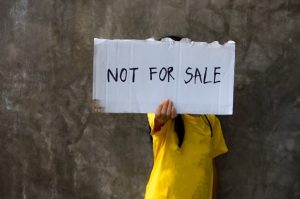Donna Chapman-Jones

Photo credit: Missisauga.com
There are approximately 4.8 million victims of sex trafficking globally, and over 99% are female. Trafficking in persons, or human trafficking, is an international human rights violation. It is also a domestic crime. Under s. 279.01 of the Canadian Criminal Code “a person who recruits, transports, transfers, receives, holds, conceals or harbours a person, or exercises control, direction or influence over the movements of a person, for the purpose of exploiting them or facilitating their exploitation is guilty of an indictable offence…” Canadian human trafficking laws are modelled off of the United Nations Protocol to Prevent, Suppress and Punish Trafficking in Persons Especially Women and Children, often called the Palermo Protocol, which has become “the accepted international framework to address human trafficking.”[1]
In Canada traffickers typically recruit, transport, harbour and control victims for the purpose of exploiting their sexual labour. However, forced labour is also a national problem. Victims often suffer physical, sexual and/or emotional abuse at the hands of their traffickers.
What are some common myths about trafficking in persons?
You can consent to being trafficked:
NO. Individuals cannot legally consent to their own trafficking.
Trafficking requires exploitation:
NO. Preliminary and preparatory conduct leading up to actual exploitation is also criminalized, although these acts may be considered less morally blameworthy in sentencing if exploitation is not proven.
The crime of trafficking requires movement or border crossing:
NO. Movement and border crossing are only required under s. 118 of Immigration and Refugee Protection Act, a different trafficking provision.
Traffickers need to satisfy all conduct in s. 279.01 to be convicted:
NO. The conduct requirement for the crime is broad and can be established in several different ways.
A finding of exploitation requires that victims must actually fear for their own safety or the safety of another to satisfy the elements of the crime:
NO. Determining a trafficker’s guilt requires an objective evaluation of whether the conduct of the trafficker would cause a reasonable person to fear for their safety or the safety of others, rather than considering the victim’s actual fear for her safety.
How are the Canadian human trafficking provisions different from the prostitution-related provisions?
There is significant overlap between the human trafficking and prostitution provisions. Sexual exploitation is a gendered issue with women and girls being disproportionately impacted by its harms. The market for sexual services is the same regardless of whether an individual freely sells sexual services in exchange for compensation or whether the individual is sold for sexual purposes by a trafficker under exploitative circumstances. This market is fueled by sex buyers who do not differentiate between buying sex from trafficked persons and buying sex from those selling sex under non-coercive circumstances.
Essentially, sex trafficking is exploitative prostitution where a third-party profits, whereas in non-exploitative prostitution, the individual sex seller earns all profits and directs their own decisions free from immediate control and coercion.[2] To qualify as exploitative, the trafficker’s conduct must cause the victim to have a reasonable fear for their safety or the safety of someone known to them. The selling of sexual services for compensation and trafficking exist on either end of the continuum of sexual exploitation.
What is the difference between human smuggling and human trafficking?
Human smuggling is a crime which involves the smuggler facilitating illegal border crossing for financial or material gain. Smugglers profit from the smuggling itself whereas traffickers profit from the ongoing exploitation of the victim. Smuggled persons most often consent to their own transport, whereas trafficking victims do not. Human trafficking is a crime against the person and a human rights violation. There does not need to be any border crossing to constitute trafficking and most trafficking victims are actually from the country they are trafficked in. Despite these differences, smuggled individuals may become trafficking victims once they enter Canada.
What supports do human trafficking survivors need during judicial proceedings?
Trafficked people are victims of both crime and human rights violations.[3] However, victims may have engaged in criminal behaviour themselves and may have significant fear and distrust of police and law enforcement. Whether they have committed any crimes or not, they may be afraid of being incarcerated or testifying in a criminal trial against the trafficker. Victims’ cooperation in criminal proceedings can therefore be challenging. “Aside from the trauma they have suffered, other sociological and psychological barriers impede the process, including sociocultural differences, language and gender.”[4]
Our trafficking laws are heavily dependent on the victim’s testimony and often it can be the only evidence the Crown presents to support their case against the trafficker. Victims can be unreliable witnesses because of the traumatic context of the trafficking relationship, often being subject, on the one hand, to abuse and coercion and, on the other hand, to psychological manipulation and romantic grooming. Whether trafficked victims are fearful and traumatized or unhealthily attached to their traffickers, they may struggle to give coherent and credible testimonies. This trauma and context of abuse must be taken into consideration when examining vulnerable witnesses and in assessing whether an accused trafficker caused them to have a reasonable fear for their safety.
Human Trafficking is an ever-growing global problem with grave domestic impact within Canada. In signing the Palermo Protocol and passing its own legislation, Canada has committed to prosecuting and punishing this crime and human rights violation, thereby protecting the women and children who are disproportionately impacted.

Photo by Bill Oxford on Unsplash
[1] Public Safety Canada, 2018 Human Trafficking Consultations Report (Ottawa: Minister of of Public Safety and Emergency Preparedness, 2018) <publicsafety.gc.ca/cnt/rsrcs/pblctns/2018-hmn-trffckng-cnslttns-rprt/index-en.aspx#s1> accessed 30 November 2019 [Human Trafficking Consultations Report].
[2] Nicole Barrett, “Laws to Combat Sex Trafficking” (2013) at 2 [Laws to Combat].
[3] Laws to Combat, supra note 2 at 35.
[4] UNODC, “Investigation of Trafficking in Persons” in Toolkit to Combat Trafficking in Persons 2nd ed (Vienna: United Nations 2008) at 189, online: <unodc.org/documents/human-trafficking/Toolkit-files/08-58296_tool_5-1.pdf>.
Donna Chapman-Jones is a second year student at Allard Law. She is passionate about justice and equality for women. When she is not at law school she enjoys playing games with her nephews and singing karaoke at home!